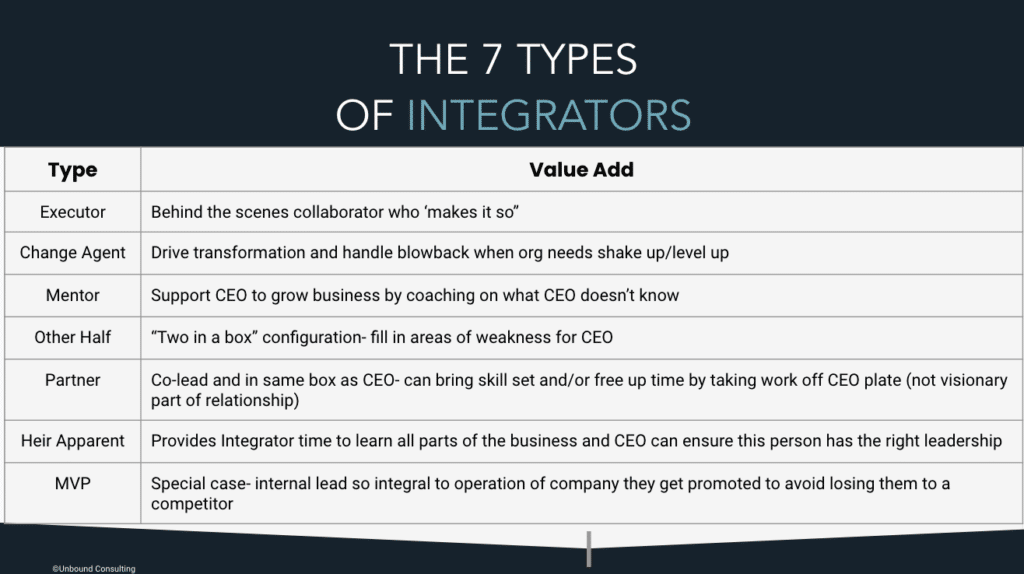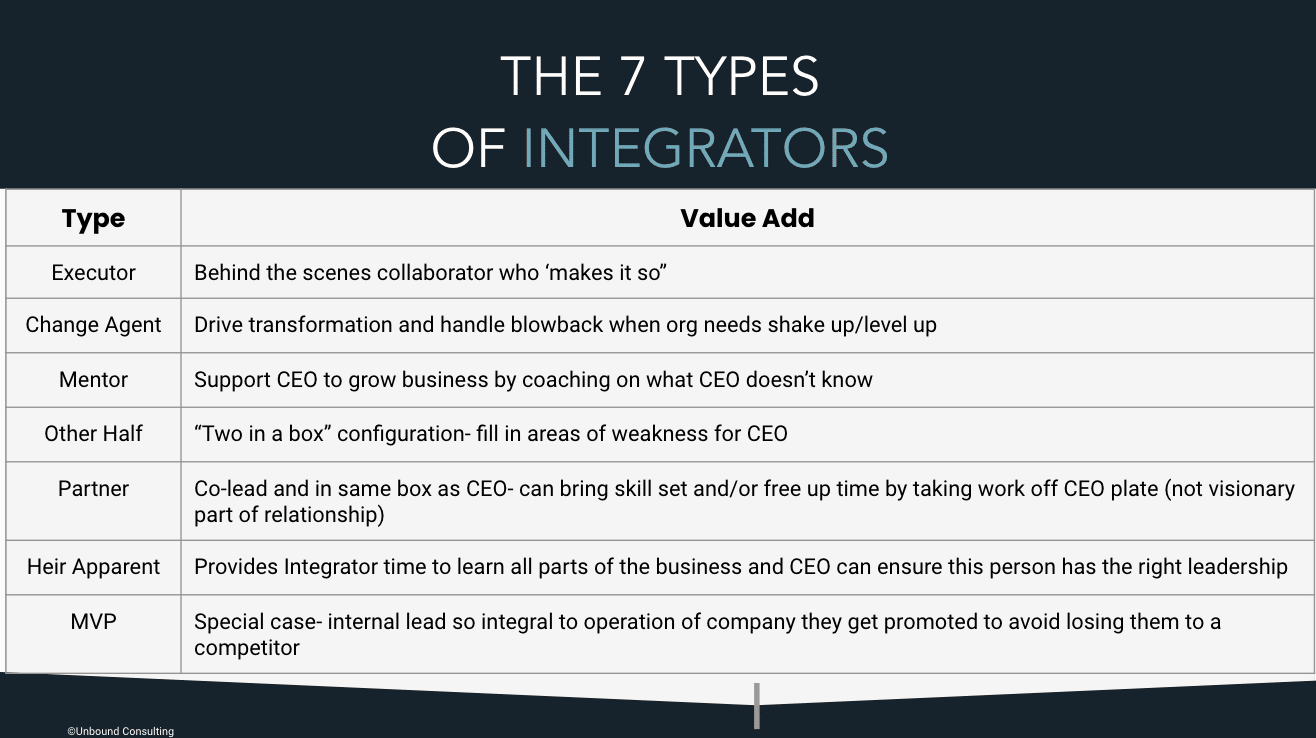Key Principles for building & maintaining an effective Visionary/Integrator Relationship
In Part 1 of It Takes Two, we covered the basics of why at the top of every successful organization there are two distinct leaders. Now that you understand the benefits at a high-level, let’s talk logistics. How do you find them, how do you keep them, and how do you get the most out of the visionary/integrator relationship.
FINDING EACH OTHER
There is a reason there aren’t any magazines dedicated to the COO role and that’s because no two COOs are alike and there isn’t a one sizes fits all match.
However, for every 5 visionaries, there is only 1 integrator so finding your right match is imperative and the competition is stiff.
So how do you find the right Integrator for you and your organization? To answer that, we start by answering another question – how much visionary do you need?
Where your company is in it’s growth stages and the value you, as a visionary, bring to the table, must be determined to answer this question. To do so, follow this process:
- Map your visionary profile. What is the greatest value that you bring to the organization? Not what are all the things you’re doing, but what are you great at and love doing?
- Now map your Integrator profile. If you were to remove everything from your plate that doesn’t fall into the “Love & Great at” category, what’s left? Do you need a partner in some of the areas you did list in the “Great/Love” category? How would you prioritize that list? Does it require more than one person?
- Initiate your search and take your time to find the right fit – I used people analytics to find my perfect match. In my case, I used Culture Index and identified the architect as the ideal match.
- Onboard your Integrator
- Be patient – this relationship takes on average a year to build

The above image is me and my Integrator, Mel. When I mapped my Integrator profile, I realized I needed someone that’s both vision and execution (i.e. the Architect) Someone that could keep up with my big ideas but bring structure and and plan to help move it forward. I also needed someone that can work with our clients solo, which means I needed someone that can switch back and forth between playing visionary and playing integrator for clients. Mel is the perfect example of just that.
As you map your Integrator profile, remember what I pointed out earlier. This relationship might require a 3rd party. Here is the perfect example. Before launching Unbound, I served as second in command to another pure visionary for 5 years, yet I’m a pure visionary myself. Why was that relationship successful? Because what the founder needed was a partner. Another visionary to help propel the company forward. But that left one BIG GAPING HOLE, Execution. So we transformed this relationship into a 3 legged leadership team with the introduction of someone we called the “Operator”. Her job, like Mel’s, what’s to be able to see the big picture and be the catalyst for moving that initiative forward.
Below is a guide that you might find helpful.

Once you find your Integrator, you need absolute core alignment in your Visionary/Integrator Relationship to harness the power of the unique combination. Standing together is critical as any small gaps between the two of you will feel like canyons to your team. To help you through this, follow these 5 rules
The Five Rules
Rule #1, Stay on the Same Page. This eliminates dysfunctional, unproductive leadership team meetings and interactions. Check in on a human level; list all issues, concerns, ideas and disconnects. Then IDS
Rule #2, No End runs. Unproductive complaining for politicking, positioning and better outcome from other employees is not the greatest use of your time. You can coach but never make a decision, doing so will cut managers off at the knees. Listen carefully and at the end of the conversation, ask “the question” – “are you going to tell them or am I? Because one of us needs to tell’em”
Rule #3, The Integrator is the Tie Breaker. Specifically, how issues pertaining to the company, Leadership Team, and day-to-day cross-departmental bottlenecks are handled
Rule #4, You are an Employee when Working IN the Business. Being the owner of the business is different from being an employee. Recognize the hat you’re wearing and don’t allow the feeling of owner’s “entitlement” to disrupt your progress
Rule #5, Maintain Mutual Respect. As the dynamic duo, you must truly respect each other. This cannot be faked.
The Core Principles
Once you’ve found your Integrator and have onboarded them properly, there are core principles to this relationship that both parties need to adhere to in order to ensure you get the most out of this relationship
PRINCIPLE 1: UPWARD COMMUNICATION
Visionary: Identify and Communicate to your integrator what’s keeping you up at night and allow them to help you. Also, look at the weekly updates your integrator provides and stay informed.
Integrator: Ask your visionary what’s keeping them up at night; observe where they’re focusing their time and energy; and proactively communicate updates and changes to items on that list and do so in a way that’s best for the visionary to receive that information
PRINCIPLE 2: PROBLEM SOLVING
Visionary: Don’t solve problems for others. Give your integrator freedom to make decisions, but oversee effectiveness of the decisions.
Integrator: Thoroughly assess the consequences (+ or -) of your decisions; be willing to mentor subordinates on consequence decision making; and encourage employees to consider alternative solutions when necessary
PRINCIPLE 3: STAYING IN YOUR LANE
Visionary: Identify your unique abilities and natural talent, share these with your integrator, monitor your activities to ensure you’re staying inside of these abilities and talents 80% of the time; and tradeoff duties with your integrator to establish highest and best use of your talent
Integrator: identify your unique abilities and talents, share these with your visionary; monitor both yours and your visionary’s activities to ensure you’re staying within these abilities at least 80% of the time; and when necessary, manage the tradeoff of duties
PRINCIPLE 4: KEEPING PRIORITIES
Visionary: Think of new ideas, pass off ideas to the integrator, allow the process of evaluation and categorization to work (Now, No, or Later); remember not all ideas are good ones and if you have passed something off to your integrator, let them do it
Integrator: Categorize new ideas in Now, no or Later files; spend the necessary time ensuring the “now” items fit the strategic plan and are developed & implemented; build a file for the later items to give confidence to your visionary that items will be brought up at the right time; kill the “no” ideas but be sensitive to your visionary’s “ownership” of those ideas; encourage your visionary to bring you new ideas
PRINCIPLE 5: REFLECTING OVER COFFEE
Visionary: Your integrator will take on the role of losing sleep – give your appreciation and praise when you see this behavior and allow it to make you feel safe.
Integrator: Meet with your Visionary to reinforce connection and ensure you are on the same page; communicate the work/ideas you are doing to support the business; be proactive in showing your visionary that you care about his ideas and about the business
PRINCIPLE 6: MAKE THE COMPANY LOOK GOOD
Share the Burden, Share the Success
Visionary: Give your integrator opportunities to make the company look good; recognize and show appreciation for when they succeed; realize you have accomplished something when your integrator stands out
Integrator: Be proactive in finding ways to make the company and the visionary look good; don’t forget who gave you the opportunity to look good; and spend the necessary time to ensure that when you’re presenting on behalf of the organization you’re producing high quality work and going overboard in making the company look GREAT.
While there is a lot of information here, you’re only scratching the surface. For more information and guidance on building the right V/I relationship, feel free to contact me for a 30 minute, ask me anything, 1-on-1 meeting. And if you KNOW you need an integrator but you’re not yet ready to pull the trigger on hiring full-time, I have the team for that. Contact Us HERE


